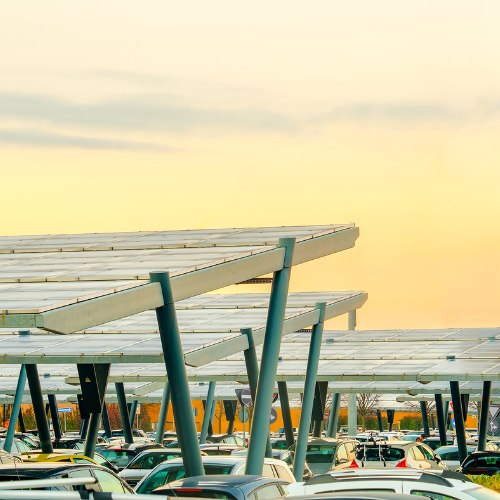Power the Future
Smart Solar Canopy

Redesigning our Cities
As we envision the future city, it’s crucial to consider how we can utilize existing spaces for new benefits. There are 8 parking spots per car in the U.S. Between 30-50% of urban areas are paved, with parking lots accounting for approximately 45% of that pavement. It’s time to make an impact.

benefits of Solar Canopies
Solar parking canopies reduce the urban heat island effect and produce cleaner energy taking strain off the grid. Parking canopies create shade for cars which requires less cooling from A/C during hot summer months. Parking canopies can house EV charging stations and storage.

Canopies vs. Rooftop Solar
We’re big fans of solar anywhere it makes sense. However, roof-top or ground-mounted solar is not always an option due to limited space and land or roof configurations. Parking lot solar mitigates these potential challenges and comes with the added benefit of covered parking giving more options.

adoption is happening
Solar canopies are being built at various locations across the US. France has mandated solar canopies on all lots with over 80 spots with the goal of generating 11 GW of renewable energy, equivalent to 10 nuclear reactors, comprising 8% of their national electricity output.
Schools & Universities
Shopping Malls & Grocery Stores
Airports
Office Buildings
Our solutions
Smart Solar Canopy
a vision for the future
Understand the impact
Walmart is installing large-scale solar canopies at some of their lots. According to a recent study, if Walmart did that at all 3,571 of its U.S. super centers, the total capacity would be 11.1 gigawatts of solar power — roughly equivalent to a dozen large coal-fired power plants. Taking account of the part-time nature of solar power, the study figures that would be enough to permanently shut down four of those power plants.
A study published in Environmental Research Letters estimates on the conservative end that there is enough existing parking to hold solar panels to generate 422 GW of power. This is significant as it’s 450% more than the current U.S. solar capacity.
Using parking spaces for solar power could also help achieve the government’s 2035 goal of 1,000 GW without taking up land for other purposes such as agriculture and housing.